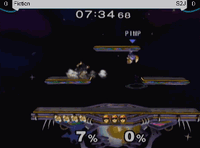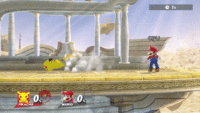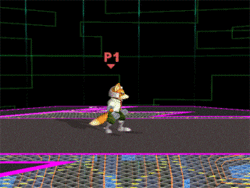Dash-dance: Difference between revisions
No edit summary |
|||
| (106 intermediate revisions by 50 users not shown) | |||
| Line 1: | Line 1: | ||
''' | {{move|dashdance|much more commonly spelled without a hyphen, this page was created back in 2006 with the current title and never moved since}} | ||
{{ArticleIcons|allgames=y}} | |||
[[File:Dashdance.gif|thumb|250px|Fox performing a frame-perfect dash-dance in ''Melee''.]] | |||
The '''dash-dance''' is an advanced technique in the ''Super Smash Bros.'' games. Performed by rapidly tapping the [[analog stick]] left and right while on the ground, it cancels out the character's initial dashing animation with another animation in the opposite direction, causing the character to quickly and repeatedly dash to the right and left in a short distance. | |||
In ''Melee'', the time window in which a character can dash and then change directions by dash-dancing matches the amount of frames in their initial dash animation. After they complete their initial dashing animation, they'll transition to their standard running animation; at this point, tapping the analog stick in the opposite direction will cause the character to enter their turnaround animation, during which no attacks can be performed. In ''Brawl'' and ''Smash 4'', characters can only reverse their direction within the first six frames of their initial dash animation, making dash dancing more difficult to perform and also less useful. | |||
In | ==In competitive play== | ||
===In ''[[Super Smash Bros.]]''=== | |||
In the original ''Super Smash Bros.'', dash-dancing takes longer to perform, because no matter how fast it is performed, there is a small turnaround animation (except for {{SSB|Captain Falcon}}). This long window leads to generally fewer applications for dash-dancing than seen in ''Melee''; however, this also allows for [[pivot]]ing to be easier to perform than in ''Melee''. | |||
===In ''[[Super Smash Bros. Melee]]''=== | |||
[[File:S2J tech-chase.gif|thumb|An application of dash-dancing in competitive ''Melee''; {{Sm|S2J}}, as {{SSBM|Captain Falcon}}, constantly uses dash-dances in order to quickly pursue {{SSBM|Fox}} out of Falcon's throws, allowing for tech-chasing.]] | |||
While dash-dancing can be performed in all five games, it sees most of its use in ''Melee''. In ''Melee'', dash-dancing is used primarily to play [[spacing]] [[mindgames]] with the opponent. By continuously switching directions, the player can confuse opponents in regards to their [[approach]], as they can potentially either backtrack or approach while dash-dancing; in addition, it can also cause opponents to attempt an attack in the dash-forward animation, only for the player to dash backwards and quickly [[punish]] the end lag of such attacks by doubling-back. As players can also jump out of a dash-dance, it can allow players to quickly use [[SHFFL]]s and [[wavedash]]es. Dash-dancing can also be used in conjunction with low-knockback [[throw]]s to perform [[tech-chase]]s, as the action allows players to quickly run in either direction, allowing for quick pursuit of rolling opponents. Characters with long dashing animations, such as {{SSBM|Fox}}, {{SSBM|Marth}}, and {{SSBM|Captain Falcon}}, make the most use of the technique, and proper use of dash-dancing is important in all of their respective metagames. {{SSBM|Sheik}} has the shortest dash, making her dash-dance harder to perform, though this also gives her a faster [[crouch cancel]] out of her run in return. | |||
=== | ===In ''[[Super Smash Bros. Brawl]]''=== | ||
In ''Brawl'', dash-dancing is more difficult to perform, as every character now has a short initial dash animation, and the window for reverse dashes ceases before the animation completes, making it difficult to consistently perform. In addition, many throws have increased knockback, which, coupled with ''Brawl''{{'}}s [[hitstun|hitstun cancelling]], makes [[tech]]-chasing more difficult. Random [[tripping]] can also interrupt dash-dancing whenever the dash input is performed, leaving the player vulnerable should it occur; as random tripping can occur whenever the control stick is tapped to the left or right on the ground, dash-dancing increases the number of opportunities for a random trip. As a result of these changes, dash-dancing is considerably less useful than it was in ''Melee'' and therefore sees little use in competitive play. The technique, however, does see some use in {{SSBB|Sonic}}'s [[metagame]], as it heavily relies on mindgames and [[punishment]] to garner KOs. | |||
''Brawl'' introduced a new method of dash-dancing, called [[#Extended dash-dancing|extended dash-dancing]]. However, this variant also sees little use in competitive ''Brawl'', as it increases the number of opportunities for tripping. | |||
== | ===In ''[[Super Smash Bros. 4]]''=== | ||
[[File:Extendeddashdance.gif|thumb|{{SSB4|Pikachu}} performing an extended dash-dance in ''SSB4'']] | |||
In ''Super Smash Bros. 4'', the removal of random tripping allows safer dash-dances than in ''Brawl''. However, no changes have been made to the general length of initial dash animations or the reverse dash window; thus, dash-dances are still difficult to perform as in ''Brawl'', and coupled with throws that are stronger than in ''Brawl'', the technique again sees very little use in competitive play. | |||
====Extended dash-dancing==== | |||
To compensate for dash-dancing's continued ineffectiveness, a number of competitive players perform a similar technique known as '''extended dash-dancing''', which returns from ''Brawl''. This maneuver combines [[fox-trotting]] and dash-dancing: the player inputs a dash and returns the control stick to a neutral position, and then inputs another dash in the same direction and quickly flicks the control stick in the opposite direction, which causes the character to change directions without going into their turn-around animation. The timing for this varies depending on each character's fox-trot window. In terms of appearance, extended dash-dancing is slower than dash-dancing in ''Melee''; this makes it less versatile while being more difficult to perform due to more frequent inputs and tighter timings, but it is still a useful technique that improves many characters' mobility. If one is adept with the inputs, mixing up between the two techniques is possible, potentially confusing opponents and pressuring them to approach or [[dodge]]. | |||
In ''Brawl'' and ''SSB4'', a dash can be cancelled with a new dash on frame 16. If a character's dash animation is shorter than 16 frames, they must return the control stick to neutral in order to avoid entering their run animation before they can dash again, so characters with longer dash animation have an easier time extended dash-dancing. | |||
Extended dash-dancing has varying degrees of usefulness on each character: | |||
*Characters such as {{SSB4|Captain Falcon}}, {{SSB4|Little Mac}}, {{SSB4|Lucina}}, {{SSB4|Marth}}, {{SSB4|Roy}}, {{SSB4|Wii Fit Trainer}}, and {{SSB4|Donkey Kong}} can use extended dash-dancing easily as their dash animations last 16 or more frames. | |||
*Characters like {{SSB4|Shulk}} and Wii Fit Trainer benefit from using extended dash-dancing over alternating foxtrots because their foxtrots cannot be interrupted quickly. | |||
*Characters such as {{SSB4|Bayonetta}}, {{SSB4|Corrin}}, {{SSB4|Diddy Kong}}, {{SSB4|Fox}}, {{SSB4|Falco}}, {{SSB4|Luigi}}, {{SSB4|Mario}}, {{SSB4|Sheik}}, and {{SSB4|Zero Suit Samus}} gain little benefit from extended dash-dancing without frame-perfect inputs because they can simply fox-trot in alternating directions for similar results without any extra effort, due to the lenient interruptibility window after their initial dash. | |||
*{{SSB4|Cloud}}, {{SSB4|Lucario}}, and {{SSB4|Mr. Game & Watch}} gain no advantage from extended dash-dancing over alternating fox-trots even with perfect timing, as their dashes have the fastest interruptibility in the game at frame 18. | |||
== | ===In ''[[Super Smash Bros. Ultimate]]''=== | ||
In ''Super Smash Bros. Ultimate'', the dashing mechanics have been altered. In addition to the small window at the start of the initial dash inherited from ''Brawl'' and ''SSB4'', a dash dance can be performed in a similar fashion to [[foxtrot]]s due to the interrupt frame for the initial dash animation being universally earlier, occurring on frame 15 for all characters. As such, any character is free to dash back without the laggy skid animation as long as the run phase of the dash has not begun. This revised dash-dancing mechanic benefits characters with fast initial dashes the most, such as {{SSBU|Zero Suit Samus}}, {{SSBU|Little Mac}}, {{SSBU|Charizard}}, {{SSBU|Bowser}}, and {{SSBU|Marth}}. | |||
Unlike in previous games, however, ''Ultimate'' now features a new additional initial dash turnaround animation for all characters which is initiated when performing an initial dash in the opposite direction; this animation is similar to the regular initial dash animation, except that at the beginning of animation, characters visibly turn themselves around to face the opposite direction. While most of the characters are unaffected by it, this new animation has adversely affected {{SSBU|Captain Falcon}} more than everyone else, since his initial dash turnaround animation during its initial frames actually slides his model toward the direction he was originally facing. This is especially noteworthy since Falcon, who has the second-fastest running speed, relies heavily on his ground game when compared to other characters. | |||
==See also== | |||
*[[Pivoting]] | *[[Pivoting]] | ||
*[[Fox-trot]] | *[[Fox-trot]] | ||
{{AllGames|Techniques}} | |||
[[Category: | [[Category:Advanced techniques]] | ||
Latest revision as of 02:48, January 7, 2024
The dash-dance is an advanced technique in the Super Smash Bros. games. Performed by rapidly tapping the analog stick left and right while on the ground, it cancels out the character's initial dashing animation with another animation in the opposite direction, causing the character to quickly and repeatedly dash to the right and left in a short distance.
In Melee, the time window in which a character can dash and then change directions by dash-dancing matches the amount of frames in their initial dash animation. After they complete their initial dashing animation, they'll transition to their standard running animation; at this point, tapping the analog stick in the opposite direction will cause the character to enter their turnaround animation, during which no attacks can be performed. In Brawl and Smash 4, characters can only reverse their direction within the first six frames of their initial dash animation, making dash dancing more difficult to perform and also less useful.
In competitive play[edit]
In Super Smash Bros.[edit]
In the original Super Smash Bros., dash-dancing takes longer to perform, because no matter how fast it is performed, there is a small turnaround animation (except for Captain Falcon). This long window leads to generally fewer applications for dash-dancing than seen in Melee; however, this also allows for pivoting to be easier to perform than in Melee.
In Super Smash Bros. Melee[edit]

While dash-dancing can be performed in all five games, it sees most of its use in Melee. In Melee, dash-dancing is used primarily to play spacing mindgames with the opponent. By continuously switching directions, the player can confuse opponents in regards to their approach, as they can potentially either backtrack or approach while dash-dancing; in addition, it can also cause opponents to attempt an attack in the dash-forward animation, only for the player to dash backwards and quickly punish the end lag of such attacks by doubling-back. As players can also jump out of a dash-dance, it can allow players to quickly use SHFFLs and wavedashes. Dash-dancing can also be used in conjunction with low-knockback throws to perform tech-chases, as the action allows players to quickly run in either direction, allowing for quick pursuit of rolling opponents. Characters with long dashing animations, such as Fox, Marth, and Captain Falcon, make the most use of the technique, and proper use of dash-dancing is important in all of their respective metagames. Sheik has the shortest dash, making her dash-dance harder to perform, though this also gives her a faster crouch cancel out of her run in return.
In Super Smash Bros. Brawl[edit]
In Brawl, dash-dancing is more difficult to perform, as every character now has a short initial dash animation, and the window for reverse dashes ceases before the animation completes, making it difficult to consistently perform. In addition, many throws have increased knockback, which, coupled with Brawl's hitstun cancelling, makes tech-chasing more difficult. Random tripping can also interrupt dash-dancing whenever the dash input is performed, leaving the player vulnerable should it occur; as random tripping can occur whenever the control stick is tapped to the left or right on the ground, dash-dancing increases the number of opportunities for a random trip. As a result of these changes, dash-dancing is considerably less useful than it was in Melee and therefore sees little use in competitive play. The technique, however, does see some use in Sonic's metagame, as it heavily relies on mindgames and punishment to garner KOs.
Brawl introduced a new method of dash-dancing, called extended dash-dancing. However, this variant also sees little use in competitive Brawl, as it increases the number of opportunities for tripping.
In Super Smash Bros. 4[edit]

In Super Smash Bros. 4, the removal of random tripping allows safer dash-dances than in Brawl. However, no changes have been made to the general length of initial dash animations or the reverse dash window; thus, dash-dances are still difficult to perform as in Brawl, and coupled with throws that are stronger than in Brawl, the technique again sees very little use in competitive play.
Extended dash-dancing[edit]
To compensate for dash-dancing's continued ineffectiveness, a number of competitive players perform a similar technique known as extended dash-dancing, which returns from Brawl. This maneuver combines fox-trotting and dash-dancing: the player inputs a dash and returns the control stick to a neutral position, and then inputs another dash in the same direction and quickly flicks the control stick in the opposite direction, which causes the character to change directions without going into their turn-around animation. The timing for this varies depending on each character's fox-trot window. In terms of appearance, extended dash-dancing is slower than dash-dancing in Melee; this makes it less versatile while being more difficult to perform due to more frequent inputs and tighter timings, but it is still a useful technique that improves many characters' mobility. If one is adept with the inputs, mixing up between the two techniques is possible, potentially confusing opponents and pressuring them to approach or dodge.
In Brawl and SSB4, a dash can be cancelled with a new dash on frame 16. If a character's dash animation is shorter than 16 frames, they must return the control stick to neutral in order to avoid entering their run animation before they can dash again, so characters with longer dash animation have an easier time extended dash-dancing.
Extended dash-dancing has varying degrees of usefulness on each character:
- Characters such as Captain Falcon, Little Mac, Lucina, Marth, Roy, Wii Fit Trainer, and Donkey Kong can use extended dash-dancing easily as their dash animations last 16 or more frames.
- Characters like Shulk and Wii Fit Trainer benefit from using extended dash-dancing over alternating foxtrots because their foxtrots cannot be interrupted quickly.
- Characters such as Bayonetta, Corrin, Diddy Kong, Fox, Falco, Luigi, Mario, Sheik, and Zero Suit Samus gain little benefit from extended dash-dancing without frame-perfect inputs because they can simply fox-trot in alternating directions for similar results without any extra effort, due to the lenient interruptibility window after their initial dash.
- Cloud, Lucario, and Mr. Game & Watch gain no advantage from extended dash-dancing over alternating fox-trots even with perfect timing, as their dashes have the fastest interruptibility in the game at frame 18.
In Super Smash Bros. Ultimate[edit]
In Super Smash Bros. Ultimate, the dashing mechanics have been altered. In addition to the small window at the start of the initial dash inherited from Brawl and SSB4, a dash dance can be performed in a similar fashion to foxtrots due to the interrupt frame for the initial dash animation being universally earlier, occurring on frame 15 for all characters. As such, any character is free to dash back without the laggy skid animation as long as the run phase of the dash has not begun. This revised dash-dancing mechanic benefits characters with fast initial dashes the most, such as Zero Suit Samus, Little Mac, Charizard, Bowser, and Marth.
Unlike in previous games, however, Ultimate now features a new additional initial dash turnaround animation for all characters which is initiated when performing an initial dash in the opposite direction; this animation is similar to the regular initial dash animation, except that at the beginning of animation, characters visibly turn themselves around to face the opposite direction. While most of the characters are unaffected by it, this new animation has adversely affected Captain Falcon more than everyone else, since his initial dash turnaround animation during its initial frames actually slides his model toward the direction he was originally facing. This is especially noteworthy since Falcon, who has the second-fastest running speed, relies heavily on his ground game when compared to other characters.

